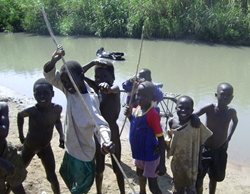Findings, implications and lessons learned
A number of conclusions can be drawn from this study. Considering each of the four objectives in turn:
- Numbers of Biomphalaria species of snails increased with decreasing altitude during the dry
 season. No snails of this species were found during the wet season. season. No snails of this species were found during the wet season.
- Biomphalaria numbers in the dry season were associated with water flow velocity and pH levels.
- The prevalence of bilharzia was lower in children up to the age of 9 than in adolescents and adults, and was overall slightly higher in males than females.
- There was an indication that the increasing numbers of Biomphalaria snail
species in the water during the dry season resulted in higher infection rates in humans.
In terms of statistical lessons:
This case study has highlighted the needs
- to anticipate in advance the ways that the data are to be statistically analysed,
- to decide in advance how best to record and enter the data into the computer,
- to ensure that recording sheets are carefully stored and data backups are kept in the event of computer problems.
|